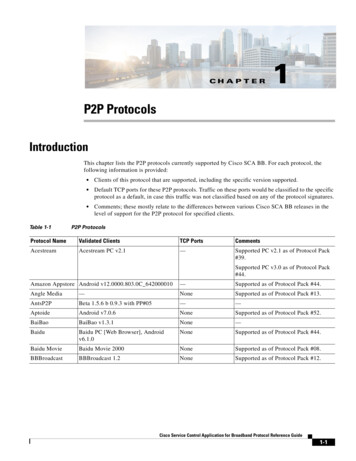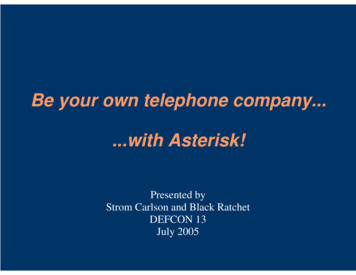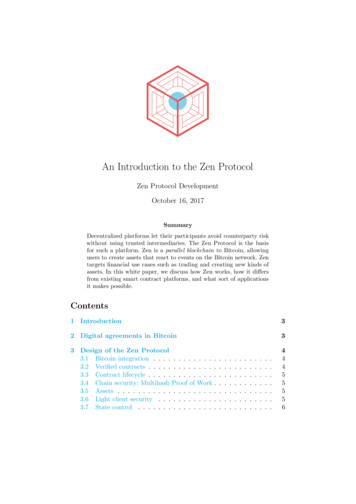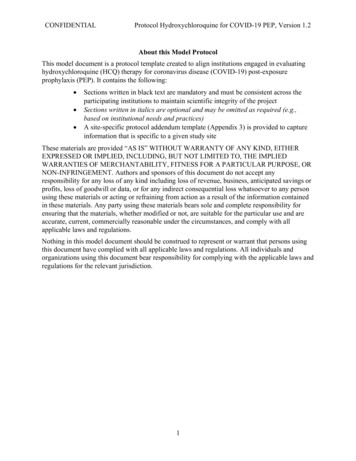
Transcription
CONFIDENTIALProtocol Hydroxychloroquine for COVID-19 PEP, Version 1.2About this Model ProtocolThis model document is a protocol template created to align institutions engaged in evaluatinghydroxychloroquine (HCQ) therapy for coronavirus disease (COVID-19) post-exposureprophylaxis (PEP). It contains the following: Sections written in black text are mandatory and must be consistent across theparticipating institutions to maintain scientific integrity of the projectSections written in italics are optional and may be omitted as required (e.g.,based on institutional needs and practices)A site-specific protocol addendum template (Appendix 3) is provided to captureinformation that is specific to a given study siteThese materials are provided “AS IS” WITHOUT WARRANTY OF ANY KIND, EITHEREXPRESSED OR IMPLIED, INCLUDING, BUT NOT LIMITED TO, THE IMPLIEDWARRANTIES OF MERCHANTABILITY, FITNESS FOR A PARTICULAR PURPOSE, ORNON-INFRINGEMENT. Authors and sponsors of this document do not accept anyresponsibility for any loss of any kind including loss of revenue, business, anticipated savings orprofits, loss of goodwill or data, or for any indirect consequential loss whatsoever to any personusing these materials or acting or refraining from action as a result of the information containedin these materials. Any party using these materials bears sole and complete responsibility forensuring that the materials, whether modified or not, are suitable for the particular use and areaccurate, current, commercially reasonable under the circumstances, and comply with allapplicable laws and regulations.Nothing in this model document should be construed to represent or warrant that persons usingthis document have complied with all applicable laws and regulations. All individuals andorganizations using this document bear responsibility for complying with the applicable laws andregulations for the relevant jurisdiction.1
CONFIDENTIALProtocol Hydroxychloroquine for COVID-19 PEP, Version 1.2CLINICAL STUDY PROTOCOLProtocol Title:Efficacy of Hydroxychloroquine for Post-exposure Prophylaxis (PEP) to Prevent Severe AcuteRespiratory Syndrome Coronavirus 2 (SARS-CoV-2) Infection Among Adults Exposed toCoronavirus Disease (COVID-19): A Blinded, Randomized StudyCompound:HydroxychloroquineShort Title:Hydroxychloroquine for COVID-19 PEPProtocol Version and Approval Date:Version 1.2; 09 April 2020Protocol Registry Number:NCT04328961Regulatory Agency Identifying Number(s):Not applicableSponsor Name and Legal Registered Address:University of WashingtonRoosevelt Way NE, Seattle, WA 98115Funding Agency and Legal Registered Address:Bill & Melinda Gates Foundation1300 I St NW, Washington, DC 20005Co-Principal Investigators:Dr. Ruanne V. Barnabas, University of WashingtonPhone: 1 206 520 3813; Email: rbarnaba@uw.eduDr. Anna Bershteyn, NYU School of MedicinePhone: 1 408 309 9610; Email: anna.bershteyn@nyulangone.orgSponsor Signatory Name and Title:09 April 2020SignatureDateMedical Monitor name and contact information is provided separately for each site.2
CONFIDENTIALProtocol Hydroxychloroquine for COVID-19 PEP, Version 1.2Table of Contents1.Synopsis .62.Schedule of Activities .2.7.3.3.Introduction.11Background .11Study Rationale .12COVID-19 and Antiviral Approaches .12Antiviral Effects of Chloroquine Analogues Against COVID-19 .13Rationale for Drug Selection .13Rationale for Dosing Schedule .14Rationale for Ascorbic Acid Control as a Comparator .15Rationale for Enrolling the Index Case for the Index Case Substudy .15Rationale for Including Genetic Testing .15Benefit/Risk Assessment .164.Objectives and Endpoints .175.5.1.5.2.Study Design .19Overall Design .19Participant and Study Completion tudy Population .21Close Contact Participants .21Inclusion Criteria .21Exclusion Criteria .21Index Cases .22Inclusion Criteria .22Exclusion Criteria .22Screen Failures.22Recruitment.22Co-enrollment Guidelines s.23Treatments Administered.23Risks to the Participants.23Risks Associated with PEP Administration with HCQ .23Risks Associated with COVID-19 Surveillance and Quarantine .24Strategies to Minimize Risk.24Dose Selection .24Management of Participants to Limit Risks of SARS-CoV-2Transmission .24Dose Modification and Toxicity Management .24Method of Treatment Assignment .26Blinding .26Preparation/Handling/Storage/Accountability .267.4.7.5.7.6.7.7.3
CONFIDENTIALProtocol Hydroxychloroquine for COVID-19 PEP, Version 1.27.8.7.9.7.9.1.7.9.2.7.10.Treatment Compliance .26Concomitant Therapy .27Prohibited Medications .27Precautionary Medications.27Treatment After the End of the Study .278.8.1.8.2.8.3.Discontinuation/Withdrawal Criteria .27Discontinuation of Study Treatment .27Withdrawal from the Study.28Lost to Follow-up .2.2.9.3.Study Encounters .28Close Contact Participants .29Screening/Baseline Evaluation: Day 0/1 .29Day 2 Through Day 13 .29Day 14 .30Exit Contact (Day 28 3) .30Participants who Develop COVID-19 During the Study .31Index Cases .31Baseline Evaluation: Day 1 .31Exit Contact (Day 28) .31Participant Reimbursement . Study Assessments and Procedures .32Efficacy Assessments .32Mid-nasal Swab .32Participant Survey .33Adverse Events .33Serious Adverse Events .33AE and SAE Attribution to Study Medication .34AE and SAE Reporting .34SAEs will be reported within 48 hours to the Sponsor. .34Grade 3 and 4 AEs assessed as related to the study medication bythe clinician will be reported to the Sponsor within 48 hours. .34Grade 1 and 2 AEs assessed as related to the study medication bythe clinician will be reported to the Sponsor within 2 weeks ofthe participant’s Exit Contact.34Reporting of Use During Pregnancy .34Reporting of Misuse of Drug .34Treatment of Overdose .34AEs Among Index Case Participants .34Safety and AE Assessments.34Dried Blood Spot Optional Sub-study .35Genetic Testing .35Samples Used for Genetic Testing .35Genetic Testing Procedures .35Genetic Information That Will Be Obtained .36Biohazard Containment .36 10.5.2.10.5.3.10.6.4
CONFIDENTIALProtocol Hydroxychloroquine for COVID-19 PEP, Version 1.3.5.11.3.6.Statistical Considerations .36Sample Size Determination .36Populations for Analyses .37Statistical Analyses .37Efficacy Analyses .38Safety Analyses.38Pharmacokinetic Analysis .38Exploratory Exposure-Response Analyses .38Exploratory Transmission Analyses .38Combined Study Analysis .3912.References .4013.Appendices.43Appendix 1: Abbreviations and Terms .43Appendix 2: Study Governance Considerations .44Appendix 3: Site-specific Protocol Addendum Template .48Appendix 4: Hydroxychloroquine Label .51Appendix 5: Physiologically Based Pharmacokinetic Modeling ofHydroxychloroquine Used for Post-exposure Prophylaxis .51Appendix 6: Pharmacokinetic Sample Collection and Analysis .515
CONFIDENTIAL1.Protocol Hydroxychloroquine for COVID-19 PEP, Version 1.2SynopsisProtocol Title:Efficacy of Hydroxychloroquine for Post-exposure Prophylaxis (PEP) to Prevent Severe AcuteRespiratory Syndrome Coronavirus 2 (SARS-CoV-2) Infection Among Adults Exposed toCoronavirus Disease (COVID-19): A blinded, Randomized StudyShort Title:Hydroxychloroquine for COVID-19 PEPRationale:Post-exposure prophylaxis (PEP) is defined as taking antimicrobial medication after beingexposed or potentially exposed to an infectious agent to prevent becoming infected.PEP is routinely used for prevention of a variety of viral, bacterial, and parasitic infections,including influenza and human immunodeficiency virus. Based on experience with PEP for otherinfections, therapy should be started as soon as possible after a recent possible exposure.Hydroxychloroquine (HCQ) is currently approved for the suppressive treatment and treatment ofacute attacks of malaria due to several Plasmodium strains. It is also indicated for the treatmentof discoid and systemic lupus erythematosus and rheumatoid arthritis. With the first Food andDrug Administration approval in 1955, safety and tolerability of HCQ are well described.In vitro, HCQ displays antiviral activity against coronaviruses, including severe acute respiratorysyndrome coronavirus 2 (SARS-CoV-2). Pharmacologic modeling based on observed drugconcentrations and in vitro drug testing suggest that prophylaxis at approved doses could preventSARS-CoV-2 infection and/or ameliorate viral shedding. Clinical trials of HCQ treatment forcoronavirus disease (COVID-19) pneumonia are underway in China under separate protocol(s).Objectives and Endpoints:ObjectivesEndpointsPrimary To test the efficacy of HCQ (400 mgorally daily for 3 days then 200 mgorally daily for an additional 11 days,to complete 14 days) to preventincident SARS-CoV-2 infection,compared to ascorbic acid amongcontacts of persons with SARS-CoV-2infection Polymerase chain reaction(PCR)-confirmed SARS-CoV-2infection (self-collected samplescollected daily Day 1 through Day 14)6
CONFIDENTIALProtocol Hydroxychloroquine for COVID-19 PEP, Version 1.2Secondary To determine the safety and tolerabilityof HCQ as SARS-CoV-2 PEP in adults Adverse events To test the efficacy of HCQ (400 mgorally daily for 3 days then 200 mgorally daily for an additional 11 days,to complete 14 days) to preventincident SARS-CoV-2 infection2 weeks after completing therapy,compared to ascorbic acid amongcontacts of persons with SARS-CoV-2infection PCR-confirmed SARS-CoV-2 infection(self-collected samples collected dailyDay 1 through Day 14 and collected2 weeks after cessation of treatment[i.e., Day 28]) To test the efficacy of HCQ to shortenthe duration of SARS-CoV-2 sheddingamong those with SARS-CoV-2infection in the HCQ PEP group SARS-CoV-2 viral shedding by PCR To test the efficacy of HCQ to preventincident COVID-19 PCR-confirmed COVID-19 diagnosispost start of HCQ therapyExploratory To conduct SARS-CoV-2 viralgenotyping to assess the impact ofHCQ on viral resistance to HCQ PEP Viral genotyping of SARS-CoV-2 in asubset of treated study participantswho develop infection To assess adherence to HCQ PEP Self-reported daily dosing and studytherapy concentration (if insub-study) in study participants To evaluate the pharmacokinetics (PK)of HCQ by infection status HCQ blood concentration To assess if there is an associationbetween PK of HCQ and the efficacyand safety endpoints evaluated HCQ blood concentration, tolerability,and efficacy To evaluate if SARS-CoV-2 viral load inthe index case is associated withSARS-CoV-2 infection in the contact SARS-CoV-2 semiquantitative PCR andgenotyping To test the efficacy of HCQ to shortenthe magnitude of SARS-CoV-2shedding among those with SARS- Daily SARS-CoV-2 semiquantitativePCR7
CONFIDENTIALProtocol Hydroxychloroquine for COVID-19 PEP, Version 1.2CoV-2 infection in the HCQ PEPgroup To investigate the association ofplausible genetic markers andsusceptibility to SARS-CoV-2 infectionand/or severity of COVID-19 Rational gene candidates associatedwith SARS-CoV-2 infection and/orCOVID-19 severityCOVID-19: coronavirus disease; HCQ: hydroxychloroquine; PEP: post-exposure prophylaxis; SARS-CoV-2: severeacute respiratory syndrome coronavirus 2.Overall Design:This is a randomized, multi-center, placebo-equivalent (ascorbic acid) controlled, blinded studyof HCQ PEP for the prevention of SARS-CoV-2 infection in adults exposed to the virus.This study will enroll up to 2000 asymptomatic men and women 18 to 80 years of age (inclusive)at baseline who are close contacts of persons with polymerase chain reaction (PCR)-confirmedSARS-CoV-2 or clinically suspected COVID-19 and a pending SARS-CoV-2 PCR test. Eligibleparticipants will be enrolled and randomized 1:1 to HCQ or ascorbic acid at the level of thehousehold (all eligible participants in 1 household will receive the same intervention).Participants will be counseled about the preliminary in vitro data on HCQ activity againstSARS-CoV-2 and equipoise regarding efficacy in humans.Participants may participate in a sub-study where they will be asked to provide a dried bloodspot sample for therapy concentration and pharmacokinetics (PK) of HCQ as well as forSARS-CoV-2 antibody testing, if possible.The index cases will be invited to participate in the index case sub-study.An independent data and safety monitoring board (DSMB) will be convened for this study withexpertise in COVID-19 or respiratory viruses, PEP, and emerging epidemics; DSMB will includea biostatistician. The purpose of the DSMB is to monitor the study for operational futility, socialharms, and efficacy.If additional data emerge on alternative effective agents for SARS-CoV-2 prophylaxis and/ordata about HCQ as PEP, the protocol could be modified through an amendment to evaluate analternative therapy as PEP. Alternatively, this platform study could be modified through anadaptive design to test the efficacy of new potential agents for COVID-19 PEP.Number of Participants:Up to 2000 eligible participants will be randomly assigned (at the level of household) 1:1 tostudy treatment (HCQ or ascorbic acid). Up to 2000 index cases will be enrolled.Treatment Groups and Duration:The duration of study participation will be approximately 28 days. Households will berandomized 1:1 (at the level of household), with close contact participants receiving one of thefollowing therapies:8
CONFIDENTIAL Protocol Hydroxychloroquine for COVID-19 PEP, Version 1.2HCQ 400 mg orally daily for 3 days then 200 mg orally daily for an additional 11 daysAscorbic acid 500 mg orally daily for 3 days then 250 mg orally daily for 11 daysAfter 14 days of treatment are completed, participants will be asked to participate in the study foran additional 14 ( 3) days.Eligible index cases will be asked to provide a mid-nasal swab at baseline to determine the viralload and complete a questionnaire at baseline and on Day 28 to report their clinical course.9
CONFIDENTIAL2.Protocol Hydroxychloroquine for COVID-19 PEP, Version 1.2Schedule of ActivitiesScreeningProcedureInformed consentDemographyPast and current medical conditions, including known pregnancyand/or lactation statusConcomitant medicationsExposure to index case informationInclusion and exclusion criteriaRandomizationMid-nasal swabStudy therapy (HCQ or ascorbic acid)Daily Survey (including dosing and swab adherence, concomitantmedications, and symptoms review)Exit Contact Survey (including concomitant medications,symptoms, etc.)Adverse Event reviewIf in sub-study: dried blood spot sample for HCQ concentrationand anti-SARS-CoV-2 antibodies (if possible)Index case participant mid-nasal swabIndex case participant questionnaireDay 0aDay 1aXXXcXcSelf-QuarantineTreatment PeriodDay 2 Day 3 Days4 Day 8to 7Days9to 13Day 14ExitContactbDay 28( 3 days)XXXXXXcX##X##X##X#X#X#X#XXXXXXXXXXXXXXXXX1 to 5 samples (no more than 1 per day)after dosing startXXXXXEOS: end of study; HCQ: hydroxychloroquine; HIPAA: Health Insurance Portability and Accountability Act; SARS-CoV-2: severe acute respiratorysyndrome coronavirus 2.Note: ## denotes either 400 mg dose HCQ or 500 mg dose of ascorbic acid (depending on group assignment); # denotes either 200 mg dose HCQ or 250 mgdose of ascorbic acid (depending on group assignment).aScreening and Day 1 evaluations will be conducted through a web-based screening tool, HIPAA-compliant video conference (Telehealth), telephone, or textmessaging. Screening and Day 1 evaluations may occur on the same day.bThese evaluations will be conducted by telephone, text messaging, or through Telehealth.cIndex case sub-study participants only.10
CONFIDENTIAL3.Protocol Hydroxychloroquine for COVID-19 PEP, Version 1.2IntroductionThis is a randomized, multi-center, placebo-equivalent (ascorbic acid) controlled, blinded studyof the efficacy of hydroxychloroquine (HCQ) post-exposure prophylaxis (PEP) for theprevention of severe acute respiratory syndrome coronavirus 2 (SARS-CoV-2) infection in adultsexposed to the virus.Evaluations include safety and tolerability, SARS-CoV-2 viral shedding, and coronavirus disease(COVID-19) diagnosis. Two study groups (one active and one receiving ascorbic acid[vitamin C], to serve as a placebo-equivalent comparator) will be enrolled to assess a dailydosing regimen administered for 14 days, which appears to be the approximate incubation periodof SARS-CoV-2 infection.Up to 2000 eligible participants 18 to 80 years of age will be randomized (at the level ofhousehold) 1:1 to receive one of the following therapies: HCQ 400 mg orally daily for 3 days then 200 mg orally daily for an additional 11 daysAscorbic acid 500 orally daily for 3 days then 250 mg orally daily for 11 daysHCQ and ascorbic acid will appear similar, and taste will be partially masked as HCQ can bebitter and ascorbic acid will be sour.During the study participants will perform the following: Collect mid-nasal swabs for viral detection for the primary trial endpointComplete Surveys that will include questions about symptoms from both the drugregimen and virus infection, review of concomitant medications, and other pertinenttopicsNote: Participants who report respiratory or other febrile illness will be referred forassessment to their primary care provider.During the first 14 study days, participants take medication, complete Surveys, and collectmid-nasal swab to assess symptoms and virus exposure. On Day 28, a final swab is collected andSurvey completed. The duration of study participation will be approximately 28 days.Up to 2000 eligible index cases for the COVID-19 PEP study will be invited to participate andasked to provide a baseline mid-nasal swab for SARS-CoV-2 testing and complete aquestionnaire at baseline and on Day 28 to report the clinical course of their illness.3.1.BackgroundSARS-CoV-2 is a coronavirus novel to the human population discovered in December 2019; it iscurrently the cause of a global pandemic [1,2,3]. The World Health Organization (WHO) namedthe novel coronavirus SARS-CoV-2 and the disease caused by SARS-CoV-2 COVID-19.As of 08 March 2020, person-to-person transmission has occurred in China, across temperateAsia, Europe, and North America, and with sporadic cases in Africa and the southernhemisphere. Accurate reporting is limited by availability of diagnostic testing. The WHOdeclared the COVID-19 pandemic a Public Health Emergency of International Concern on30 January 2020 [4], and the United States declared a national emergency on 13 March 2020 [5].11
CONFIDENTIALProtocol Hydroxychloroquine for COVID-19 PEP, Version 1.2Most deaths and severe pneumonitis have occurred in the elderly or in persons with underlyingpulmonary or cardiac comorbidities or diabetes. In healthy adults, including pregnant women, itcan cause a febrile, self-limited pneumonia. Infection appears less symptomatic in children andyounger adults [6]. Nevertheless, the burden of this pandemic to the global health and economicsystems is expected to be substantial. No acquired immunity to this novel viral infection appearsto exist in the human population globally, and no effective treatment or preventative agent islicensed at this time.As with many infectious epidemics, household contacts, first responders, caregivers, and medicalpersonnel attending persons with COVID-19 are at high risk of infection. The incubation timerequires 14 days of quarantine for exposed individuals not wearing personal protectiveequipment [7], and on 03 March 2020, WHO declared a global shortage of personal protectiveequipment leaving doctors, nurses, and other frontline workers dangerously ill-equipped to carefor COVID-19 patients [8]. Extensive absences from the care network and health system willdegrade the ability to care not only for those with COVID-19 but also for routine healthcareissues as well.PEP is defined as taking antimicrobial medication after potential exposure to an infectious agentto prevent becoming infected. PEP should be started as soon as possible after a recent possibleexposure to the infectious agent [9]. At this time, there is no known effective prophylaxis forCOVID-19 and thus there is equipoise for testing a non-active comparator (e.g., ascorbic acid)against a potentially active drug.3.2.3.2.1.Study RationaleCOVID-19 and Antiviral ApproachesSARS-CoV-2 is a novel betacoronavirus of zoonotic origin, similar to the coronaviruses severeacute respiratory syndrome coronavirus (SARS-CoV) and Middle East respiratory syndromecoronavirus (MERS). Based on current evidence, case fatality rate for SARS-CoV-2 is about 3%,which is significantly lower than SARS-CoV (10%) and MERS-CoV (40%) [10]. However,SARS-CoV-2 has potentially higher transmissibility (R0: 1.4-5.5) than both SARS-CoV(R0: 2-5) and MERS-CoV (R0: 1) [10].Our understa
CONFIDENTIAL Protocol Hydroxychloroquine for COVID-19 PEP, Version 1.2 1 About this Model Protocol This model document is a protocol template created to align institutions engaged in evaluating hydroxychloroquine (HCQ) therapy for coronavirus disease (COVID-19) post-exposure prophylaxis (PEP). It contains the following:
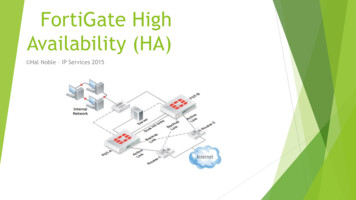
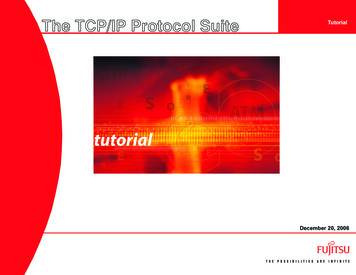
![[MS-OFBA]: Office Forms Based Authentication Protocol](/img/3/ms-ofba.jpg)
